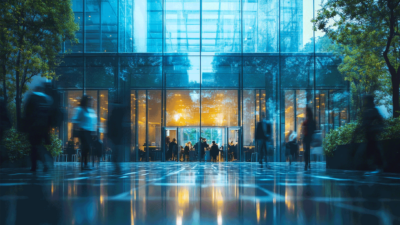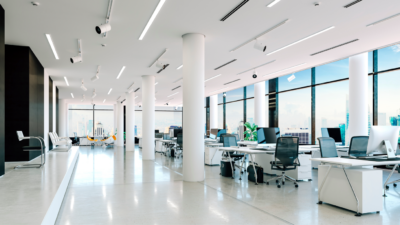“Open office” — these are not just buzz words. Virtually every client we work with is interested in how an open office environment can benefit their workplace and their business. Whether expanding, relocating, contracting or just optimizing, open office design is often the first topic that comes up.
But what exactly does the term mean? And more importantly, what will an open office environment mean for your business?
While perhaps the hottest trend in commercial office space, the concept is not new, and there are considerable differences in how the concept is defined and executed.
The legendary architect Frank Lloyd Wright designed an open plan for the S.C. Johnson Co. in 1936. In the 1950s, German design group Quickborner introduced partitions to add privacy and create groupings in what was called the “office landscape.” Then in 1968, Herman Miller introduced the Action Office system. It was the world’s first open-plan office system of reconfigurable components. Invented by Robert Propst, president of Herman Miller’s research division, it transformed the workplace. But eventually to reduce costs, many companies only integrated the space-saving aspects, resulting in high-density cubicle farms that a disappointed Propst came to call “monolithic insanity.”
More recently, many offices lowered cubicle walls or removed them entirely without incorporating any other design elements, resulting in countless reports of employee dissatisfaction. The lack of quiet or “head-down” space, meeting areas and other amenities were often cited as the cause.
Today we seem to have come full circle as our clients locally and around the globe have begun to rethink their office designs and look to their architects and designers to create a cost-effective workspace that provides a positive environment for their employees and increases productivity.
WHAT ARE THE ELEMENTS OF A GOOD OPEN OFFICE ENVIRONMENT?
Is it benching, portable desks, libraries, quiet pods, huddle areas or shared offices? Will a game room, juice bar or fitness center create the magic?
There is no one-size-fits-all solution.
My work with leading architectural design firms in the Philadelphia region and across the country reinforces one fundamental constant: Good design is not a stock commodity, it is the result of good communication between the end user and their space designer. Creating a successful open office environment requires an in-depth understanding of a business’ operation, their unique drivers and goals, and their culture.
WHAT ARE THE BENEFITS OF A GOOD OPEN OFFICE ENVIRONMENT?
Let’s take a look. Our clients and others who have successfully incorporated open design plans report many of the following benefits:
- An increase in employee engagement, satisfaction and well-being. If your employees like the space they work in and if it allows them to work more comfortably, they will feel better about their time at work and spend more time in the office.
- Creativity and collaboration. Workspaces that support individual tasks and foster teamwork have been shown to increase productivity.
- Recruitment and retention of the best talent. Highly skilled and valued workers have choices today. An open, high-performing work environment can be a real draw to get and retain the best talent in your industry.
- Sustainability and environmental responsibility. Increasingly a priority for employees and clients, sustainable and environmentally responsible practices can range from lighting, heating and cooling to the very materials used to build and furnish your space.
- Your workspace provides a window into your company’s culture and values — not just to your current employees and clients, but to those employees and clients you want to attract. The elements of good design convey a powerful first impression.
It stands to reason that with the right environment — a collaborative and motivating workspace — your people will do their best work. It can enhance and promote your culture and attract and retain the best talent — all of which can positively impact your bottom line.
Sure, you will have to balance just how open you want your workspace to be. And it’s a delicate balance. When an open office plan fails, it is almost always because not enough of the critically important ancillary space was provided. But with a good designer who asks the right questions, you can achieve a more productive workplace that supports your business and desired culture.
SO WHAT ARE THE FIRST STEPS?
Know your business and what drives it. Know your company’s culture and long-term goals. This can be an opportunity to re-evaluate the image as well as the culture of your organization. Are you in the best location to attract and retain the right talent? Does your building enable an environment that resonates with clients and employees?
TOP FIVE TIPS:
- Bring your design team in early, at the very start.
- Furniture is more important than you think. It will define spaces and support myriad functions.
- Your building will impact your design. Amenities can enhance success.
- Engage your employees in the process. They will know they are valued.
- Take pictures! Share your new design with the world — it can be great PR.
A good tenant representative and creative design team can help you answer these questions and develop a successful strategy for going forward, whether you are selecting a new location or staying in place. And by investing in good design, you are investing in your company’s future success.
David Dickson is a senior vice president based in Conshohocken, PA, where he focuses on tenant advisory. David is a dog lover and home brewer who advises corporate office users and writes about workplace strategies.

 David Dickson
David Dickson
 Marianne Skorupski
Marianne Skorupski
 Aaron Jodka
Aaron Jodka
 Michael Lirtzman
Michael Lirtzman Kevin Gonzalez
Kevin Gonzalez Kim Kendall
Kim Kendall Ashley Harrison
Ashley Harrison